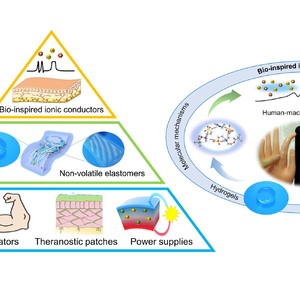Bioinspired Quasi-Solid Ionic Conductors: Materials, Processing, and Applications
Citation
Zhouyue Lei, and Peiyi Wu*. Bioinspired Quasi-Solid Ionic Conductors: Materials, Processing, and Applications. Acc. Mater. Res. 2021, 2, 1203-1214.
Abstract
Human–machine interactions in the era of the Internet of Things call for the development of intelligent bionic materials. Inspired by the biological tissues’ macromolecular networks and ionic signals, quasi-solid ionic conductors, including artificial hydrogels and nonvolatile ionic elastomers, have attracted increasing interest as a promising candidate to facilitate the human–machine interactions. Benefiting from many bionic features such as biocompatibility, softness, and ionic conductivity, the quasi-solid ionic conductors evolve various functions and achieve a broad scope of applications. This Account highlights the recent progress of bioinspired quasi-solid ionic conductors as a versatile platform for human–machine interactions. It covers topics ranging from materials, processing, and applications to future opportunities and challenges. We begin by introducing bioinspired concepts and the history of artificial ionic conductors. Then, we discuss the optimization of quasi-solid ionic conductors in terms of mechanical performance, sensory capabilities, optical properties, and environmental stability. Afterward, we introduce processing methods and discuss the integration possibility and recyclability of quasi-solid ionic conductors. Next, we show the human–machine interactions enabled by the quasi-solid ionic conductors, including skin-like sensors, theranostic patches, and ionic power supplies. In the end, we describe the exciting future of integrated artificial ionic systems and briefly discuss opportunities in bioinspired designs and practical applications of the quasi-solid ionic conductors.


